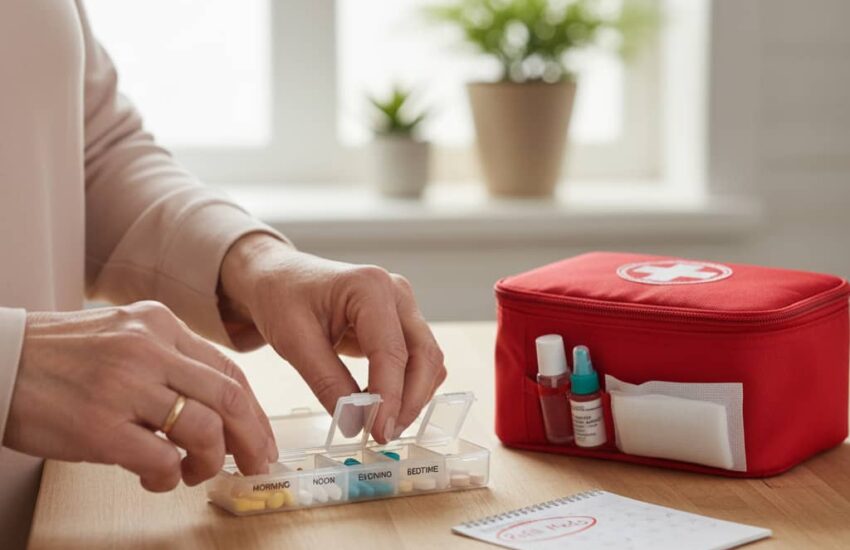I learned the true meaning of preparedness not from emergency broadcasts or government pamphlets, but from watching my elderly neighbor, Mr. Henderson, navigate a five-day power outage after an ice storm paralyzed our community. On the third day, I found him sitting in his cold living room, carefully dividing his heart medication in half to make it last until the roads cleared. That moment, seeing this proud, independent man rationing essential medicine, transformed my understanding of what disaster preparedness really means for seniors. It’s not about surviving; it’s about maintaining dignity and health when ordinary systems fail. A disaster supply kit does more than provide supplies; it preserves dignity and independence for seniors during emergencies. Learn what to include and how it transforms crisis response.
A well-considered disaster kit serves as more than just a collection of supplies; it becomes a bridge between vulnerability and self-reliance during emergencies. For seniors, particularly those managing chronic health conditions or mobility challenges, this kit represents the difference between weathering a crisis with confidence and facing potentially life-threatening gaps in care. The contents need to address not only universal emergency needs but also the specific physical, medical, and emotional realities of aging.
The medical component forms the cornerstone of an effective senior disaster kit. This includes at least a two-week supply of all prescription medications, a detail many people overlook until they’re counting pills by candlelight. Beyond the medications themselves, the kit should contain a clearly printed list detailing drug names, dosages, prescribing physicians, and pharmacy contacts. For temperature-sensitive medications like insulin, a small cooler with reusable ice packs becomes essential. During Mr. Henderson’s ordeal, we discovered his blood pressure medication was crucial, but so were the simpler things—extra hearing aid batteries, spare glasses, and waterproof containers for his daily pill organizer.
Communication tools require special consideration for older adults. A hand-crank emergency radio provides critical information without depending on batteries, while a waterproof list of emergency contacts, including family, neighbors, and doctors, should be stored alongside a charged power bank for cell phones. For seniors with hearing challenges, I learned to include a notepad and permanent marker for written communication, and for those with vision impairment, a magnifying glass can make reading instructions possible.
Nutrition and hydration needs change significantly with age. While the standard recommendation is one gallon of water per person daily, seniors on diuretics or with heart conditions may need to monitor fluid intake more carefully. I watched my own mother struggle with twist-off water bottle caps during an emergency drill, teaching me the importance of including easy-open containers. For food, soft, ready-to-eat options that accommodate dental issues or swallowing difficulties become crucial, think protein shakes, pudding cups, and low-sodium soups that don’t require cooking or refrigeration.
Comfort and dignity items may seem secondary until you’ve witnessed their power during a crisis. A familiar blanket, family photographs, or a religious item can provide profound psychological stability when normal routines are shattered. For seniors with cognitive challenges, these familiar objects can reduce anxiety and prevent dangerous confusion. After the ice storm passed, Mr. Henderson told me the thing he missed most wasn’t the television or the lights; it was his morning coffee ritual, a realization that prompted me to include instant coffee and a thermal mug in his updated emergency kit.
Mobility and safety equipment should reflect individual capabilities. A folding cane or walker takes minimal space but could prevent catastrophic falls in darkened homes. Non-slip mats, glow sticks for nighttime navigation, and a sturdy whistle for signaling help address the unique safety challenges seniors face during disasters. For wheelchair users, extra padding for pressure sore prevention and basic repair tools become essential additions.
The psychological benefit of having a prepared kit transcends its practical utility. I watched Mr. Henderson’s posture change after we assembled his supplies; the subtle anxiety that made him check weather forecasts constantly eased into quiet confidence. His kit became a physical manifestation of his resilience, a tangible reminder that he could face uncertainties without surrendering his hard-won independence. This emotional security is perhaps the most undervalued yet powerful aspect of disaster preparedness for seniors.
Maintaining the kit requires establishing simple routines—checking expiration dates when clocks change for daylight saving time, rotating medications with each pharmacy refill, and updating documents during annual physicals. Storing supplies in multiple lightweight containers rather than one heavy bin makes them portable if evacuation becomes necessary, and keeping a smaller version in the car creates protection beyond the home.
What began as a response to a crisis transformed into an ongoing conversation about resilience. Mr. Henderson’s disaster kit didn’t just store supplies; it stored peace of mind. It represented his ability to meet challenges on his own terms, to maintain his health and dignity when ordinary systems failed. In the end, that’s what disaster preparedness for seniors truly offers: not just survival, but the preservation of self when the world temporarily falls apart.
References
Tunstall Healthcare. (2025, July 20). The importance of emergency preparedness kits for seniors. https://www.tunstallhealthcare.com.au/blog/importance-of-emergency-preparedness-kits-for-seniors
Ready.gov. (2025, May 1). Older adults. https://www.ready.gov/older-adults
Oregon Department of Human Services. (2025, June 17). Emergency kits and batteries are available for eligible older adults and people with disabilities. https://apps.oregon.gov/oregon-newsroom/OR/ODHS/Posts/Post/blog-emergency-kits-batteries-available-for-eligible-older-adults-people-with-disabilities
National Institute on Aging. (2025, June 4). Infographic: 10 emergency kit essentials. https://www.nia.nih.gov/health/safety/10-emergency-kit-essentials
University of Kentucky. (2021, December 31). Older adults: Disaster preparedness. https://fcs-hes.ca.uky.edu/content/older-adults-disaster-preparedness

